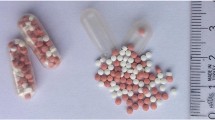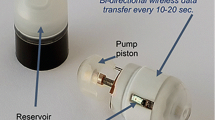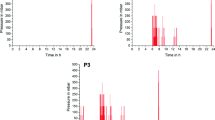Summary
The absorption of a theophylline solution containing 80–120 mg doses delivered to different sites in the gastro-intestinal tract has been determined in 3 male volunteers using a remote controlled drug release system (HF-capsule). There was no difference between the stomach, ileum and the colon in the amount of theophylline absorbed (AUC). The T1/2abs of theophylline absorbed via the colon was prolonged when compared with that entering via the upper gastro-intestinal tract. The results provide a rational basis for the further development of theophylline formulations and are indispensable for planned development and to account for variation in the bioavailability of retarded release drug preparations.
Similar content being viewed by others
References
Hirtz J (1984) The absorption window: Fact or fiction? Pharmacy Internat 5 (7): pp 175–178
Schuster O, Hugemann B, Graul EH, Loew D (1984) Absorptionslokalisation von Furosemid durch Verwendung einer ferngesteuerten Arzneimittelkapsel unter Röntgen- und CT-Kontrolle. In: Graul EH, Loew D (eds) Pathophysiologie und Therapie des gestörten Natrium- und Wasserhaushaltes, (Workshop Diuretika '84, Bad Nauheim April 1984), Medicef 1984, pp 128–137
Caldwell J, Staib AH, Cotgreave IA, Siebert-Weigel M (1986) Intraindividual comparison of theophylline pharmacokinetics in human volunteers after intravenous infusion with ethylenediamine or sodium glycinate. Br J Clin Pharmacol 22: (in press)
Jusko WJ, Polisczcuk A (1976) High-pressure liquid chromatographic and spectrophotometric assays for theophylline in biological fluids. Am J Hosp Pharm 33: 1193–1196
Wagner JG (1975) Fundamentals of clinical pharmacokinetics. Drug Intelligence Publications, Hamilton, Illinois
Betzien G, Kaufmann B, Schneider B, Ritschel WA (1985) KINPAK — a new program package for standardized evaluation of kinetic parameters. Arzneimittelforsch 35 [I] 1: 14–20
Hendeles L, Weinberger M, Johnson G (1980) Theophylline. In: Evans WE, Schentag JJ, Jusko WI (eds) Applied pharmacokinetics. Principles of therapeutic drug monitoring. Applied therapeutics, Inc. San Francisco 1980, chapter 6: pp 95–138
Frömming KH, Schwabe L, Staib AH, Rietbrock N, Lassmann A, Molz KH, Schuppan D, Siebert-Weigel M, Voegele D (1983) Untersuchungen zur Liberation, Absorption und Elimination von Theophyllin bei rasch und verzögert freisetzenden oralen Arzneiformen. Arzneimittelforsch 33 [I] 3: 446–452
Schuppan D, Molz KH, Staib AH, Rietbrock N (1981) Bioavailability of theophylline from a sustained-release aminophylline formulation (Euphyllin retard tablets)-plasma levels after single and multiple oral doses. Int J Clin Pharmacol Ther Tox 19 [5]: 223–227
Bolme P, Edlund PO, Eriksson M, Paalzow L, Winbladh B (1979) Pharmacokinetics of theophylline in young children with asthma: Comparison of rectal enema and suppositories. Eur J Clin Pharmacol 16: 133–139
De Leede LGJ, De Boer AG, Van Vuelzen SL, Breimer DD (1982) Zero-order rectal delivery of theophylline in man with an osmotic system. J Pharmacokinet Biopharm 10 [5]: 525–537
Graul EH, Loew D, Schuster O (1985) Voraussetzung für die Entwicklung einer sinnvollen Retard- und Diuretikakombination — Untersuchungen von Furosemid in verschiedenen Darmabschnitten. Therapiewoche 35: 4277–4291
Schuster O, Haertel M, Hugemann B, Gikalov I, Schiemann O, Fenner H (1985) Untersuchungen zur klinischen Pharmakokinetik von Allopurinol, I. Mitt.: Allopurinol — Absorptionsorte und Dosisproportionalität der Allopurinol/Oxipurinol-Bioverfügbarkeit. Arzneimittelforsch 35 [I] 4: 760–765
Staib AH, Loew D, Harder S, Graul EH, Pfab R, Hugemann B (1985) Theophylline absorption at different gastrointestinal sites in the man: Studies employing a remote control liberation system (HF-capsule). Arch Pharmacol 330 [suppl] R 15 (abstr 66)
Hugemann B, Schuster O (1982) Vorrichtung zur Freisetzung von Substanzen an definierten Orten des Verdauungstraktes. Patentschrift DE 2928477 C3 (A 61 K 9/00)
Riegelman S, Collier P (1980) The application of statistical moment theory to the evaluation of in vivo dissolution time and absorption time. J Pharmacokinet Biopharm 8 [5]: 509–534
Author information
Authors and Affiliations
Additional information
in technical collaboration with B. Hugemann, Frankfurt/Main
Rights and permissions
About this article
Cite this article
Staib, A.H., Loew, D., Harder, S. et al. Measurement of theophylline absorption from different regions of the gastro-intestinal tract using a remote controlled durg delivery device. Eur J Clin Pharmacol 30, 691–697 (1986). https://doi.org/10.1007/BF00608217
Received:
Accepted:
Issue Date:
DOI: https://doi.org/10.1007/BF00608217




